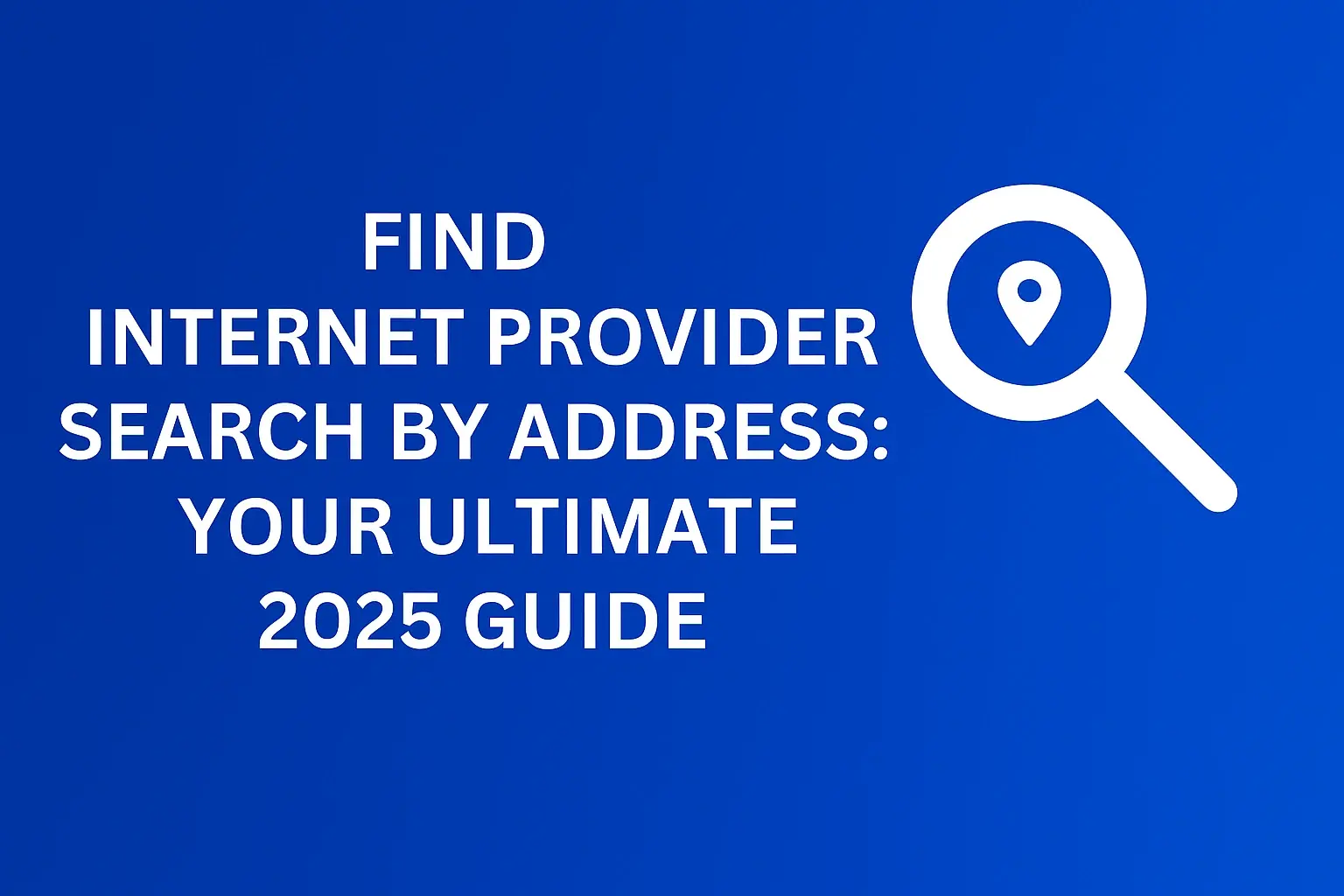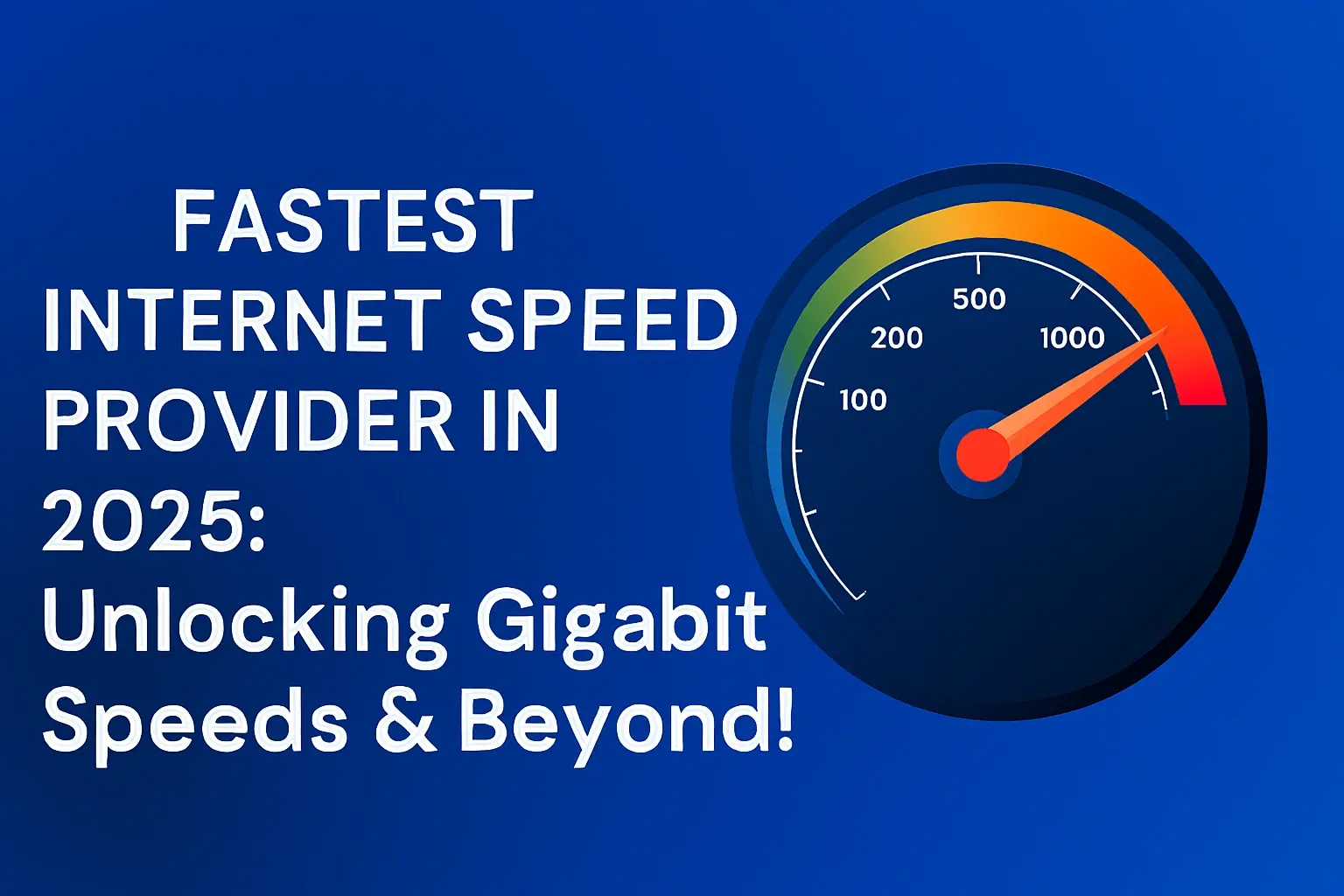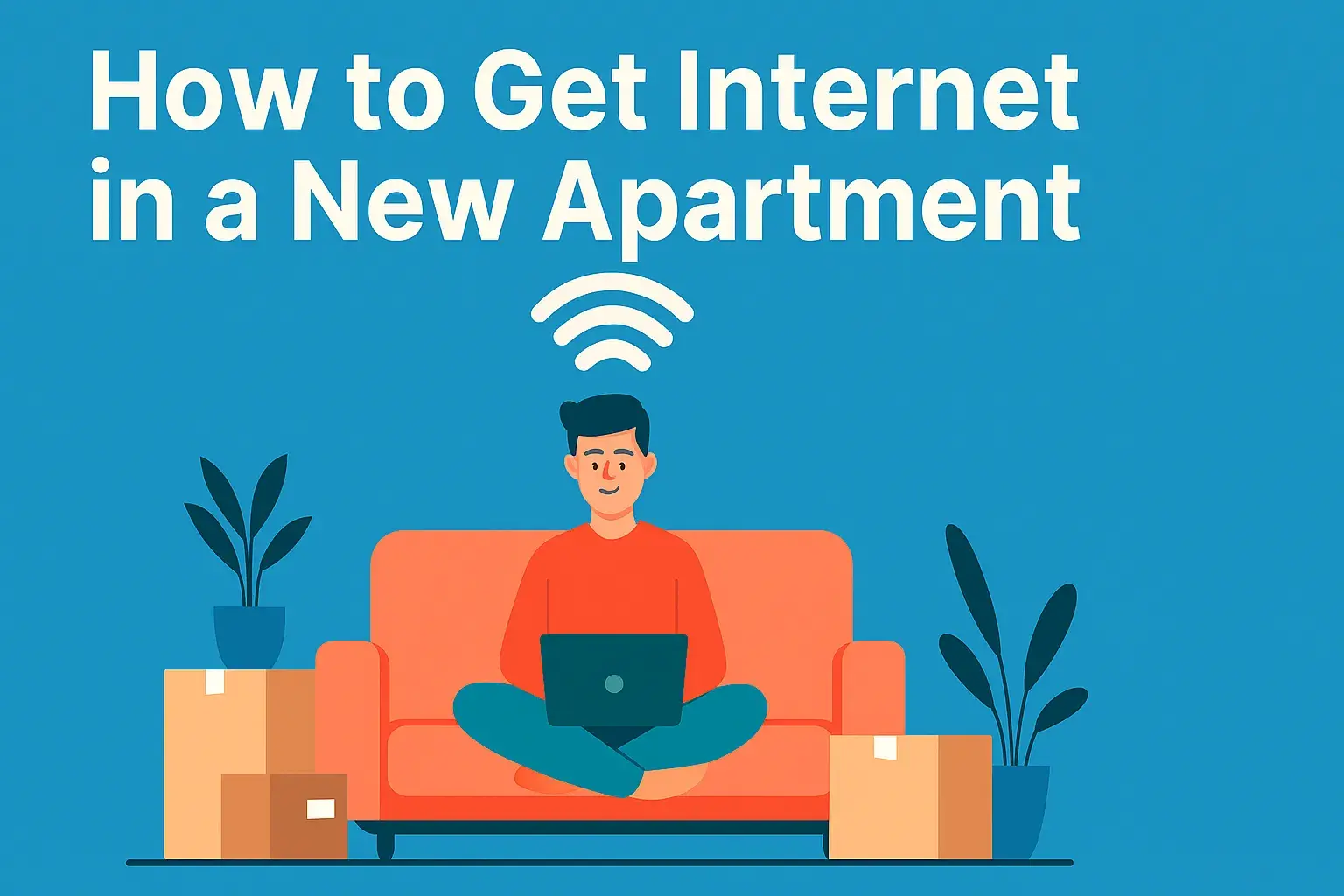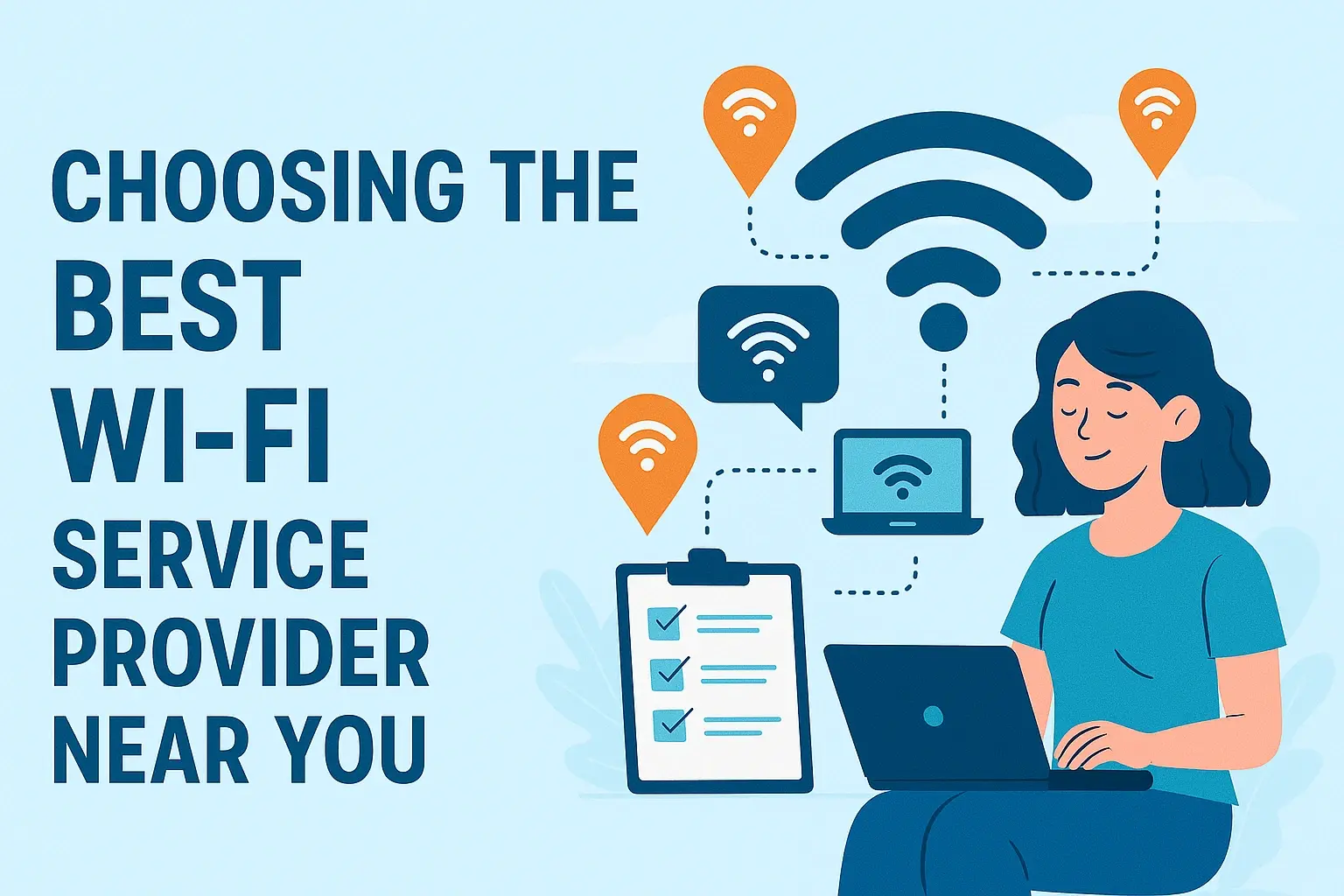Effortless Switch: How to Change Internet Provider Easily

Switching internet providers doesn't have to be a hassle. This comprehensive guide, updated for 2025, details how to effortlessly change your internet service. Learn about current trends, essential steps, comparison strategies, and best practices to ensure a smooth transition and secure the best deal for your needs.
Effortless Switch: How to Change Internet Provider Easily
In today's hyper-connected world, a reliable and fast internet connection is no longer a luxury; it's a necessity. Whether you're working from home, streaming your favorite shows, gaming online, or simply staying in touch with loved ones, your internet provider plays a crucial role in your daily life. However, many consumers find themselves stuck with subpar service, high prices, or outdated technology, often due to the perceived complexity and hassle of switching providers. This article is designed to demystify the process, providing a clear, actionable roadmap to help you make an effortless switch to a new internet provider. We'll cover everything from understanding your current plan to navigating the latest 2025 trends, ensuring you can upgrade your internet experience with confidence and ease. By the end of this guide, you'll be equipped with the knowledge to find a provider that truly meets your needs and budget, without the usual headaches.
Understanding Your Current Internet Service
Before embarking on the journey to find a new internet provider, it's crucial to thoroughly understand your current service. This self-assessment forms the foundation for making an informed decision. Many people pay for internet speeds they don't use or are unaware of hidden fees that inflate their monthly bills. Taking the time to dissect your current plan will empower you to identify what you truly need and what you can do without.
Reviewing Your Current Plan Details
Start by pulling up your latest internet bill. Examine it closely for the following:
- Advertised vs. Actual Speeds: Your bill will likely state the download and upload speeds you're paying for. However, the actual speeds you receive can vary significantly due to network congestion, your equipment, and the provider's infrastructure. Running speed tests at different times of the day (e.g., peak evening hours vs. early morning) can give you a realistic picture. Websites like Speedtest.net or Fast.com are excellent tools for this.
- Data Caps: Some plans, especially satellite or older DSL plans, come with data caps. If you exceed these limits, you might face throttling (reduced speeds) or overage charges. Understand your typical monthly data usage. Most providers offer tools to track this, or you can estimate based on your streaming and downloading habits. As of 2025, unlimited data plans are becoming more standard for cable and fiber, but it's still worth checking.
- Contract Length and Early Termination Fees (ETFs): Check if you are currently under a contract. If so, note the end date and the amount of any ETF. Breaking a contract prematurely can be expensive and might negate the savings of switching to a new provider. Many providers offer incentives to cover ETFs, but this needs to be factored into your cost analysis.
- Equipment Rental Fees: Are you renting a modem or router from your provider? These monthly fees can add up significantly over time. Often, purchasing your own compatible equipment can be a cost-saving measure in the long run, though it requires an initial investment and compatibility checks.
- Promotional vs. Standard Pricing: Many introductory offers expire after a certain period (e.g., 12 or 24 months), leading to a substantial price increase. Understand what your bill will look like after the promotional period ends. This is often the biggest motivator for switching.
- Bundled Services: If you have a bundle (internet, TV, phone), analyze the cost of each component. Sometimes, unbundling and getting services from different providers can be cheaper.
Assessing Your Internet Needs
Once you understand what you're currently paying for and receiving, assess your actual internet needs. Consider the following:
- Number of Users and Devices: How many people live in your household, and how many devices (smartphones, tablets, laptops, smart TVs, gaming consoles, smart home devices) are connected simultaneously? More users and devices generally require higher speeds.
- Primary Internet Activities: What do you primarily use the internet for?
- Basic Browsing & Email: Lower speeds (e.g., 25-50 Mbps download) are usually sufficient.
- Streaming HD/4K Video: Recommended speeds start around 50-100 Mbps download, especially for multiple streams.
- Online Gaming: Requires not just download speed but also low latency (ping) and stable upload speeds for multiplayer interactions. 100+ Mbps download is advisable.
- Video Conferencing (Work/School): Good download and especially upload speeds are crucial for smooth, uninterrupted calls. 50-100 Mbps download and 10-20 Mbps upload are good targets.
- Large File Downloads/Uploads: For professionals or heavy users, higher speeds, particularly symmetrical fiber speeds (equal download and upload), are highly beneficial.
- Future Needs: Are you expecting to add more devices, start working from home, or increase your streaming habits? Consider planning for slightly higher speeds than you currently need.
By understanding your current service and your actual needs, you can confidently approach new providers and articulate exactly what you're looking for, making the switching process much more targeted and efficient.
The Evolving Landscape: Internet Trends in 2025
The internet service provider (ISP) market is dynamic, with technological advancements and shifting consumer demands constantly reshaping the landscape. Staying informed about current trends in 2025 is key to making a smart choice and ensuring you're not left behind with outdated technology or service plans.
Dominance of Fiber Optic Technology
Fiber optic internet continues its aggressive expansion across urban, suburban, and even some rural areas. Fiber offers significantly higher speeds, lower latency, and greater reliability compared to traditional cable or DSL. As of 2025, gigabit (1000 Mbps) and multi-gigabit speeds are becoming increasingly common and affordable, especially in areas with competitive fiber deployments. If fiber is available in your area, it should be your top consideration for a future-proof connection.
5G Home Internet's Growing Role
Wireless home internet, particularly 5G, is emerging as a viable alternative, especially in areas underserved by traditional wired broadband. Major carriers are expanding their 5G home internet offerings, providing competitive speeds and often simpler, no-contract plans. While it may not yet match the peak performance of fiber in all cases, 5G home internet offers flexibility and can be a great option for moderate users or as a backup connection. Providers are continually investing in network upgrades, so performance is expected to improve year over year.
Increased Focus on Symmetrical Speeds
Historically, internet plans have offered much higher download speeds than upload speeds. However, with the rise of video conferencing, cloud backups, and content creation, upload speed is becoming equally important. Fiber optic providers are increasingly offering symmetrical speeds (e.g., 1000 Mbps download and 1000 Mbps upload), which is a significant advantage for remote workers and content creators. Cable providers are also improving their upload capabilities, but fiber generally remains the leader in this regard.
Bundling Strategies and Unbundling Trends
ISPs continue to offer bundles (internet, TV, phone) to lock in customers. However, there's a growing trend among consumers to unbundle services and seek out the best individual offerings. With the proliferation of streaming services, many people are cutting the cord on traditional cable TV. This means that the "best" bundle for one household might not be the best for another. It's essential to evaluate whether bundling truly saves you money or if piecing together services from different providers offers better value and flexibility.
Customer Service and Transparency as Differentiators
As the market becomes more competitive, providers are increasingly recognizing the importance of customer service and transparent pricing. Consumers are more vocal than ever about poor service, hidden fees, and long wait times. Providers that offer clear pricing, straightforward contracts, and responsive customer support are gaining an edge. Look for reviews and consumer reports that highlight customer satisfaction metrics when choosing a new provider.
The Rise of Fixed Wireless Access (FWA)
Beyond 5G, other forms of Fixed Wireless Access (FWA) are also improving, particularly in rural areas. These technologies use radio signals to connect homes to a nearby tower, offering an alternative to satellite or DSL where fiber or cable isn't feasible. While speeds can vary, FWA is becoming a more robust option for basic to moderate internet usage, often with lower latency than satellite.
By understanding these 2025 trends, you can better evaluate the options available to you and make a choice that aligns with current technological capabilities and your future needs.
Your Step-by-Step Guide to Switching Providers
Switching internet providers doesn't have to be a daunting task. By following a structured approach, you can ensure a smooth transition with minimal disruption. This guide breaks down the process into manageable steps.
Step 1: Research Available Providers and Plans
Using the insights from Section 2 and Section 3, begin researching providers in your specific area. Use online comparison tools and visit the websites of major ISPs (e.g., Comcast/Xfinity, Spectrum, Verizon Fios, AT&T Fiber, CenturyLink, T-Mobile Home Internet, Starlink) and smaller, local providers. Pay close attention to:
- Availability: Not all providers service every address. Enter your zip code or full address on their websites to check availability.
- Technology Type: Fiber, Cable, DSL, 5G Home Internet, Satellite. Prioritize fiber if available.
- Speed Tiers: Match the advertised speeds to your assessed needs.
- Pricing: Note introductory offers, standard rates after promotions, and any potential price increases.
- Data Caps: Look for unlimited plans.
- Contract Terms: Prefer no-contract options if possible.
- Installation Fees: Some providers charge for professional installation.
- Equipment Costs: Rental fees vs. purchasing your own.
Step 2: Contact Potential Providers and Get Quotes
Once you have a shortlist, contact the providers directly. This is often the best way to get the most accurate and up-to-date pricing, including any special offers not advertised online. Don't hesitate to negotiate. Mention competitor pricing if you have it. Ask clarifying questions about:
- The exact speeds (download and upload) you will receive.
- The total monthly cost, including all fees and taxes, after any promotional period.
- The contract length and any ETFs.
- The installation process and associated costs.
- Details about their equipment (modem/router) and options.
Step 3: Choose Your New Provider and Schedule Installation
After comparing quotes and offers, select the provider that best meets your needs and budget. Once you've decided, schedule your installation appointment. Be aware that installation appointments can sometimes be booked weeks in advance, especially during peak times or in high-demand areas. Try to schedule it for a day when you can be home for the duration of the appointment, which can take anywhere from 1 to 4 hours depending on the complexity.
Step 4: Prepare for Installation Day
On the day of the installation, ensure the area where the modem and router will be placed is accessible. If you're using your own equipment, make sure it's ready and compatible. The technician will typically run a new line (if necessary), install an outlet or modem jack, and connect your equipment. They should also test the connection to ensure it's working correctly and meets the advertised speeds.
Step 5: Activate Your New Service and Test
Once the technician has completed the installation, your new service should be active. Immediately perform speed tests (download and upload) at various locations in your home using a wired Ethernet connection if possible. Test Wi-Fi speeds on different devices and in different rooms. Check that all your essential online activities (streaming, browsing, video calls) are working smoothly.
Step 6: Cancel Your Old Service
This is a critical step that many people overlook, leading to duplicate charges. Do NOT cancel your old service until your new service is fully installed, activated, and tested. Once you've confirmed your new internet is working reliably, contact your old provider to cancel. Be prepared to return any rented equipment (modem, router, set-top boxes) to avoid unreturned equipment fees. Ask for confirmation of cancellation and a final bill. Note the date you cancel to ensure you're not billed for service beyond that date.
Step 7: Set Up Your Home Network
If you purchased your own router, configure its settings, including setting a strong Wi-Fi password (WPA3 is recommended for 2025). If your new provider supplied a modem/router combo, ensure you change the default administrative password for security. Consider the placement of your router to optimize Wi-Fi coverage throughout your home.
By meticulously following these steps, you can navigate the switching process with confidence and achieve an effortless transition to better internet service.
Comparing Providers: What to Look For
Choosing the right internet provider involves more than just looking at the advertised headline price. A thorough comparison will ensure you get the best value and performance for your specific needs. Here's a breakdown of key comparison points:
| Feature | Fiber Optic | Cable Internet | DSL Internet | 5G Home Internet | Satellite Internet |
|---|---|---|---|---|---|
| Availability | Expanding, but still limited in some areas. | Widely available in most urban and suburban areas. | Available in many areas, especially where cable/fiber are not. Performance degrades with distance from the central office. | Rapidly expanding, requires 5G network coverage. | Available almost anywhere with a clear view of the sky. |
| Download Speeds | Highest (100 Mbps - 10 Gbps+). | Good to Very High (100 Mbps - 2 Gbps+). | Low to Moderate (1 Mbps - 100 Mbps). | Moderate to High (50 Mbps - 1 Gbps+). Varies by network congestion. | Low to Moderate (25 Mbps - 150 Mbps). |
| Upload Speeds | Highest (Symmetrical speeds common, 100 Mbps - 10 Gbps+). | Lower than download (e.g., 10 Mbps - 100 Mbps). Improving. | Very Low (e.g., 1 Mbps - 10 Mbps). | Moderate to High (10 Mbps - 100 Mbps+). Varies. | Very Low (e.g., 1 Mbps - 5 Mbps). |
| Latency (Ping) | Lowest (<10 ms). Ideal for gaming and real-time applications. | Low to Moderate (10 ms - 50 ms). Good for most uses. | Moderate to High (20 ms - 100+ ms). | Low to Moderate (20 ms - 60 ms). Can fluctuate. | Highest (400 ms - 700+ ms). Unsuitable for real-time gaming. |
| Reliability & Consistency | Highest. Least affected by network congestion. | Good, but can be affected by neighborhood usage (shared bandwidth). | Generally reliable but can degrade with distance. | Can be affected by network congestion and signal strength. | Can be affected by weather (rain fade) and line-of-sight obstructions. |
| Data Caps | Rarely, if ever. | Becoming less common, but still exist on some plans. Always check. | Less common, but possible on older plans. | Often unlimited, but check terms for potential throttling after high usage. | Common, often with high overage charges or severe throttling. |
| Pricing Structure | Can be higher upfront, but often better long-term value due to performance. | Competitive, with many promotional offers. Watch for price hikes after intro period. | Often the cheapest, but speeds are limited. | Often simple pricing, sometimes bundled with mobile plans. Competitive. | Can be expensive for the speeds offered. Equipment purchase often required. |
| Contract Terms | Often no-contract or short-term contracts. | Varies; some offer no-contract, others have 1-2 year terms. | Often no-contract. | Increasingly no-contract. | Often requires long-term contracts (1-2 years). |
Key Comparison Metrics to Prioritize:
- Price Per Megabit Per Second (Mbps): Divide the monthly cost by the download speed. This gives a standardized way to compare value across different speed tiers.
- Upload Speed Importance: Don't underestimate upload speed. If you work from home, stream live, or upload large files, prioritize providers offering higher upload speeds, ideally symmetrical.
- Total Cost of Ownership: Factor in installation fees, equipment rental/purchase costs, and the price after any promotional period ends.
- Customer Service Reputation: Check consumer reviews and reports (e.g., JD Power, Consumer Reports) for provider satisfaction scores.
- Contract Flexibility: No-contract plans offer the most flexibility if your needs change or if you anticipate moving.
By using this comparison framework, you can move beyond superficial marketing and make a truly informed decision about which internet provider is the best fit for your household.
Best Practices for a Seamless Transition
Executing a smooth internet provider switch involves more than just signing up for a new service. Adhering to best practices can prevent common pitfalls and ensure a hassle-free experience. Here are essential tips for a seamless transition:
- Never Cancel Your Old Service Prematurely: This is the cardinal rule. Wait until your new internet service is fully installed, activated, and confirmed to be working correctly. Canceling too early can leave you without internet access, making it difficult to manage the final stages of the switch or troubleshoot issues.
- Understand Your Contract Thoroughly: Before signing up with a new provider, read the contract carefully. Pay attention to the fine print regarding contract length, early termination fees (ETFs), data caps, price increases after promotional periods, and any service guarantees. If you're breaking a contract with your old provider, understand the ETF and factor it into your total cost comparison.
- Consider Purchasing Your Own Modem/Router: While providers offer rental equipment, purchasing your own compatible modem and router can save you money in the long run. Rental fees can add up to hundreds of dollars over a few years. Ensure the equipment you buy is on your new provider's approved list to avoid compatibility issues.
- Schedule Installation Strategically: If possible, schedule your installation on a day when you can be home for the entire appointment window. Avoid peak times if possible, as installation slots can fill up quickly. Consider scheduling it mid-week if you work from home, as weekend appointments may be more limited.
- Test Thoroughly After Installation: Don't just assume everything is working. Perform speed tests (both wired and wireless) in multiple locations around your home. Test different devices and applications (streaming, video calls, gaming) to ensure performance meets expectations. Document your findings.
- Keep Records of Everything: Save copies of your contracts, installation confirmations, final bills from your old provider, and any communication with both your old and new ISPs. This documentation is invaluable if disputes arise.
- Return Equipment Promptly and Properly: When canceling your old service, make sure to return any rented equipment (modems, routers, TV boxes) according to the provider's instructions. Get a receipt or confirmation of return to avoid charges for unreturned items.
- Secure Your Wi-Fi Network: Once your new service is active, immediately change the default administrator password for your router and set a strong, unique Wi-Fi password using WPA3 encryption if available. This protects your network from unauthorized access.
- Be Prepared for Potential Service Gaps (Minimize Them): While the goal is a seamless transition, minor overlaps or brief gaps can occasionally occur. Try to schedule the cancellation of your old service and the activation of your new service on the same day if possible, or with minimal overlap.
- Understand Your New Provider's Support System: Familiarize yourself with how to contact your new provider's customer support, whether it's via phone, chat, or an online portal. Know their operating hours and typical response times.
Implementing these best practices will significantly increase your chances of an effortless and successful internet provider switch.
Troubleshooting Common Switching Issues
Despite careful planning, sometimes issues can arise during the internet provider switching process. Being prepared to troubleshoot can save you time and frustration. Here are common problems and their solutions:
Issue: New Internet Service Not Working After Installation
Possible Causes: Faulty equipment, incorrect activation, line issues, modem/router not syncing.
Solutions:
- Reboot Equipment: Unplug both the modem and router, wait 30 seconds, then plug the modem back in. Wait for it to fully boot up (indicator lights stable), then plug in the router.
- Check Connections: Ensure all cables (coaxial, Ethernet, power) are securely connected.
- Verify Activation: Contact your new provider to confirm your service has been activated on their end.<
Related Stories





